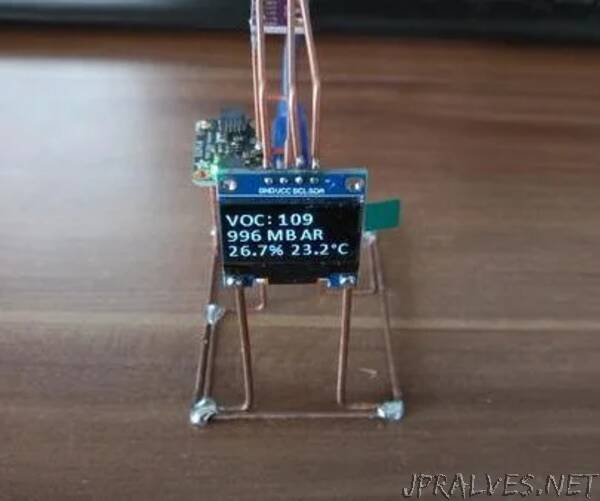
“The following instructable explains how to build a simple indoor air quality monitor. Through this monitoring you can better organize the ventilation in your rooms. And thus improve health and prevent mold. The following measured variables are displayed:
VOC Index (based on a evaluation algorithm from Sensirion)
Relative humidity [%]
Temperature [°C]
Pressure [mbar]
It doesnt show the CO2 and the PM2.5 values, which are also interesting to validate the air quality. A CO2 sensor is of interest if the concentration of aerosols, and thus indirectly the risk of infection with COVID-19, is to be determined. With the presented measurement setup, a tendency can also be determined. However, one must be careful with the interpretation. This is because the increase in aerosols increases strongly with the number of people in the room, while the VOC content is not so strongly influenced by this.
In the following, some short descriptions about the measured values.
Relative Humidity & Temperature
The relative humidity is up to the absolute humidity and the temperature. Warm air can absorb more humidity than cold air. Monitoring of the relative humidity indoors makes sense because of 2 reasons: If we stay longer in rooms with dry air, our respiratory tract dry out. This is a reason for the increase in colds in winter. Furthermore, other undesirable effects such as headaches, decrease in concentration, etc. can be promoted. On the other hand, excessive humidity can lead to mold growth when a critical dew point is reached. There is a lot more of interesting information on the subject of humidity on the web. For example here:
English wiki about humidity
One can sometimes find slightly different values, which are recommended for the interior. From my point of view, a range of 40 - 60% is a good guideline.
VOC (Volatile organic compound)
In short VOC are organic chemicals which evaporate at room temperatures and higher temperatures. They have many different sources, for example furniture, solvents, plastics, cleaning agents and many more. If their content in the air becomes to much in a room, staying in there can be harmful to health for humans. Remedy can be achieved through proper ventilation. However, because the human nose does not always register when the air is getting bad, monitoring by sensor technology provides additional safety.
This was just a short description, and there is much more information about VOC. For example here:
English wiki about VOC
Pressure
The pressure is also measured by the sensor used, and is just nice to have.
Components & material
Arduino Nano
SGP40 sensor (Sensirion)
BME280 sensor (Bosch)
OLED display (0.96 inch with SSD1306 driver IC)
Rigid wires (1.5mm², 2.5mm²)
Soldering tin
Tools
Soldering iron
Cordless screwdriver (to straighten the wires)
Various pliers (for me a small needle nose pliers in combination with a side cutter work well)”
